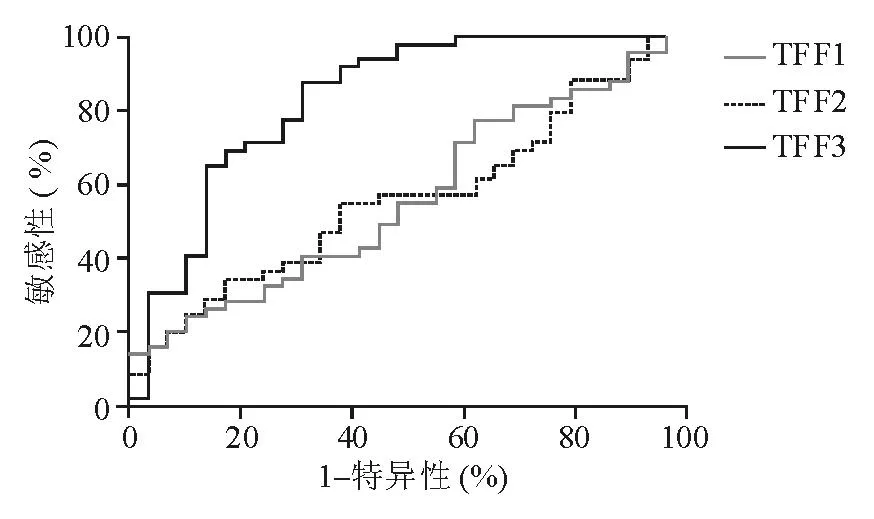血清三叶因子3在胃癌中表达的临床研究*
血清三叶因子3在胃癌中表达的临床研究*
张谢1#宋毓飞1张学松1黄志刚2&
宁波市医疗中心李惠利医院消化内科1(315040)上海市东方医院消化内科2
背景:在中国恶性肿瘤发病率和死亡率排序中,胃癌分居第二和第三位。探索方法简便、敏感性高的非侵入性指标以筛选出胃癌高危人群接受胃镜检查是胃癌普查的有效途径。目的:探讨三叶因子3(TFF3)作为胃癌筛查血清生物学标记物的临床价值。方法:收集宁波市医疗中心李惠利医院2013年7月—2014年1月49例胃癌患者和29名健康体检者的血清标本,采用ELISA法检测血清TFFs浓度,以ROC曲线及其曲线下面积(AUC)分析血清TFF1、TFF2、TFF3对胃癌的诊断性能,并进一步分析三者与胃癌临床病理特征的关系。结果:胃癌组TFF3血清浓度显著高于健康对照组[(43.57±19.49) ng/mL对(29.97±14.20) ng/mL,P<0.01],两组间TFF1、TFF2血清浓度差异无统计学意义(P>0.05)。血清TFF1、TFF2、TFF3诊断胃癌的AUC分别为0.56、0.56和0.83,TFF3诊断性能最高;以33.0 ng/mL为TFF3 cut off值,相应敏感性和特异性分别为63.3%和82.8%,预测胃癌风险的OR值为8.27。TFF3血清浓度与胃癌TNM分期、分化程度和淋巴结转移显著相关(P<0.05)。结论:血清TFF3是一个有应用前景的非侵入性胃癌筛查生物学标记物。
关键词胃肿瘤;筛查;生物学标记;三叶因子3
Clinical Research of Serum Trefoil Factor 3 Expression in Gastric Cancer
ZHANGXie1,SONGYufei1,ZHANGXuesong1,HUANGZhigang2.1DepartmentofGastroenterology,NingboMedicalTreatmentCenterLihuiliHospital,Ningbo,ZhejiangProvince(315040);2DepartmentofGastroenterology,ShanghaiEastHospital,Shanghai
Correspondence to: HUANG Zhigang, Email: huangzg@foxmail.com
Background: Gastric cancer is the second most frequently diagnosed cancer and the third cause of cancer death in China. Selection of candidates in high risk of gastric cancer by a simple and non-invasive marker with high sensitivity and then undergoing endoscopy is an optimal approach for large scale gastric cancer screening. Aims: To evaluate the clinical value of using trefoil factor 3 (TFF3) as a serum biomarker for gastric cancer screening. Methods: Serum samples of 49 gastric cancer patients and 29 healthy subjects were collected for measurements of serum TFFs by ELISA from Jul. 2013 to Jan. 2014 at Ningbo Medical Treatment Center Lihuili Hospital. ROC curve and the area under curve (AUC) were used to verify the diagnostic performance of serum TFF1, TFF2 and TFF3 for gastric cancer. Correlations between TFFs and clinicopathological characteristics of gastric cancer were further analyzed. Results: Serum concentration of TFF3 in gastric cancer group was significantly higher than that in healthy controls [(43.57±19.49) ng/mLvs. (29.97±14.20) ng/mL,P<0.01], but no significant differences were found in serum concentrations of TFF1 and TFF2 between the two groups (P>0.05). AUC of serum TFF1, TFF2 and TFF3 for diagnosis of gastric cancer were 0.56, 0.56 and 0.83, respectively, which indicated that the performance of TFF3 was the best. Taken 33.0 ng/mL as the cut off value of TFF3, the sensitivity and specificity were 63.3% and 82.8%, respectively, and the odds ratio for predicting gastric cancer was 8.27. Significant correlations were existed between serum concentration of TFF3 and TNM stage, differentiation and lymph node metastasis of gastric cancer (P<0.05). Conclusions: Serum TFF3 is a promising non-invasive biomarker for gastric cancer screening.
Key wordsStomach Neoplasms;Screening;Biological Markers;Trefoil Factor 3
胃癌是最常见的恶性肿瘤之一,全球每年确诊例数约为100万例[1]。在大多数国家(包括中国),胃癌患者确诊时多已处于进展期,预后相对较差。日本从20世纪60年代开始应用X线钡餐和内镜技术开展胃癌筛查,成功检出大量早期胃癌,使胃癌相关死亡率降低40%~60%[2-4]。然而,胃镜检查过程较痛苦,令很多患者望而却步,故不适合作为无症状人群的普查手段。探索方法简便、敏感性高的非侵入性指标以筛选出胃癌高危人群接受胃镜检查是适用于胃癌普查的有效途径。
近年来,肿瘤标记物的研究和应用已成为恶性肿瘤研究中引人注目的新领域。三叶因子(trefoil factors, TFFs)家族是一组由胃肠道黏液细胞分泌的含保守三叶结构域、耐热、耐蛋白酶的小分子多肽,哺乳动物体内的TFFs包括TFF1、TFF2、TFF3三种[5]。正常情况下,TFF1和TFF2主要表达于胃,TFF3则表达于小肠和结肠杯状细胞,同时在胰管、乳腺、唾液腺、呼吸道、下丘脑等组织器官中亦有表达[6-7]。TFFs在胃肠道黏膜上皮的修复、重建以及肿瘤发生、发展中发挥重要作用[8],本课题组前期研究[9]发现较之胃蛋白酶原(pepsinogens, PGs)Ⅰ/Ⅱ比值,血清TFF3可能是一个更好的胃癌预测指标。本研究旨在进一步探讨TFF3作为胃癌筛查血清生物学标记物的临床价值。
对象与方法
一、标本来源
收集宁波市医疗中心李惠利医院2013年7月—2014年1月胃小肠外科收治的49例胃癌患者的血清标本。入选条件:①经胃镜活检病理检查确诊为胃癌;②患者未接受任何放、化疗;③无其他器官系统肿瘤病史。胃癌临床病理分期参照第7版AJCC胃癌TNM分期系统[10]。另收集同一医院同期29名无上消化道疾病史健康体检者的血清标本作为对照。入组研究对象均排除有严重合并症(包括心、肺、肝、肾、血液系统疾病)、有上消化道手术史或迷走神经切断史者。研究方案经医院伦理委员会批准,参与者均签署知情同意书。
二、血清TFFs检测
取血清标本,按相应ELISA试剂盒(武汉优尔生科技股份有限公司)说明书进行操作,检测TFF1、TFF2、TFF3浓度。每一样品设2个复孔,结果取均值。
三、统计学分析

结果
一、基本临床特征
49例胃癌患者中男32例,女17例,男女比例1.88∶1,平均年龄(60.35±8.47)岁;29例健康对照者中男17例,女12例,男女比例1.42∶1,平均年龄(56.93±7.41)岁。两组间性别、年龄差异无统计学意义(χ2=0.35,P>0.05;t=1.80,P>0.05)。胃癌组早期胃癌(TNM分期0、ⅠA、ⅠB期)27例(55.1%),进展期胃癌(TNM分期Ⅱ~Ⅳ期)22例(44.9%);39例(79.6%)肿瘤直径≤5 cm,10例(20.4%)>5 cm;26例(53.1%)为高中分化胃癌,23例(46.9%)为低分化胃癌;23例(46.9%)无淋巴结转移,26例(53.1%)有1~5个转移淋巴结。
二、TFFs血清浓度
胃癌组TFF1、TFF2、TFF3平均血清浓度分别为(0.83±0.40)ng/mL(95% CI: 0.72~0.94)、(0.80±0.69)ng/mL(95% CI: 0.60~0.99)和(43.57±19.49)ng/mL(95% CI: 37.97~49.17),而健康对照组分别为(0.72±0.30)ng/mL(95% CI: 0.72~0.94)、(0.61±0.46)ng/mL(95% CI: 0.43~0.78)和(29.97±14.20)ng/mL(95% CI: 24.57~35.38),两组间TFF1(t=1.24,P>0.05)、TFF2(t=1.33,P>0.05)浓度差异无统计学意义,TFF3在胃癌组中的浓度显著高于健康对照组(t=3.27,P<0.01)(图1)。进一步按胃癌TNM分期作分组分析,早期胃癌TFF3平均血清浓度为(37.09±10.20)ng/mL(95% CI: 32.97~41.21),仍显著高于健康对照组(t=2.11,P<0.05)。
三、血清TFFs诊断性能的ROC曲线分析

图1 胃癌组和健康对照组TFFs血清浓度比较
血清TFF1、TFF2、TFF3诊断胃癌的ROC曲线见图2,三者的AUC分别为0.56(95% CI: 0.43~0.69)、0.56(95% CI: 0.43~0.69)和0.83(95% CI: 0.72~0.93)(图2),TFF3诊断性能最高。

图2 血清TFFs诊断胃癌的ROC 曲线
根据ROC曲线,血清TFF1、TFF2、TFF3诊断胃癌 的临界值(cut off值)分别为0.56、0.60和33.0 ng/mL,TFF3相应敏感性和特异性分别为63.3%(31/49)和82.8%(24/29),OR值为8.27,提示TFF3血清浓度与胃癌风险显著相关(表1)。
四、TFFs血清浓度与胃癌临床病理特征的关系
根据胃癌TNM分期、肿瘤大小、分化程度和淋巴结转移情况分组,比较组间TFFs血清浓度差异,结果显示TFF1血清浓度与上述胃癌临床病理特征均无明显联系(P>0.05),TFF2血清浓度仅与胃癌分化程度显著相关(P<0.05),TFF3血清浓度与胃癌TNM分期、分化程度和淋巴结转移显著相关,早期胃癌、 高中分化胃癌、 无淋巴结转移的胃癌TFF3血清浓度分别显著低于进展期胃癌、低分化胃癌和有淋巴结转移的胃癌(P均<0.05) ,而与胃癌大小无明显相关性(P>0.05)(表2)。

表2 TFFs血清浓度与胃癌临床病理特征的关系

表1 血清TFFs对胃癌诊断性能的分析
讨论
在中国恶性肿瘤发病率和死亡率排序中,胃癌分居第二和第三位[11]。早期诊断和早期治疗是降低胃癌死亡率的惟一途径,但我国胃癌患者确诊时尚处于早期者不足10%,日本则高达60%,这可能得益于日本对无症状人群的普查策略,目前应用最广泛的是血清幽门螺杆菌(Hp)抗体和PGⅠ/Ⅱ联合检测[12-14]。然而本课题组前期研究[9]发现,血清PGⅠ/Ⅱ比值预测胃癌风险的敏感性仅为37.5%,特异性为81.1%,与日本研究[15]报道的敏感性(67%)相比相对较低,可能与研究对象的地域来源、胃癌组织学类型以及Hp感染情况等有关,提示PGs单项检测并不是理想的胃癌筛查指标。
Kaise等[15]于2011年首次报道TFFs(特别是TFF3)血清浓度与胃癌显著相关,并通过进一步的研究[16]发现,TFF3血清浓度不受Hp根除状态的影响,较之TFF1、TFF2和PG试验,是预测胃癌风险的稳定生物学标记物。本课题组前期研究[9]亦表明,与PG试验相比,血清TFF3可能是一个更好的胃癌预测指标,其敏感性和特异性分别为66.7%和83.8%。因此,本研究收集胃癌患者和健康体检者的血清标本行TFFs检测,对TFF3作为中国人群胃癌筛查指标的可行性进行了探讨。研究结果显示,在所检测的TFFs中,仅TFF3血清浓度显著高于健康对照组,ROC曲线分析亦显示血清TFF3对胃癌的诊断性能最高(AUC 0.83),敏感性和特异性分别为63.3%和82.8%,预测胃癌风险的OR值为8.27,与前期研究结果相符,但TFFs的cut off值有所不同(前期研究TFF1、TFF2、TFF3 cut off值分别为0.44、0.14和52.0 ng/mL,本次分别为0.56、0.60 和 33.0 ng/mL),可能与试剂盒批次不同以及研究对象之间的差异有关,前期研究血清标本多源自进展期胃癌(77.8%)、低分化胃癌(69.4%)患者,而本次血清标本早期胃癌(55.1%)、高中分化胃癌(53.1%)均占半数以上。
本研究进一步分析了TFFs血清浓度与胃癌临床病理特征的关系,发现TFF1血清浓度与之无明显联系,既往研究[17]亦显示胃癌组织中的TFF1表达仅与肿瘤生长范围有关,与其他临床病理特征均无相关性。TFF1的主要作用是参与正常胃黏膜细胞的分化、更新,研究发现人胃癌组织中的TFF1表达较正常组织显著下调[18],TFF1基因敲除小鼠可发生胃腺瘤甚至上皮内或黏膜内癌[19],这在一定程度上可以解释TFF1血清浓度与胃癌临床病理特征无明显相关性。本课题组前期研究[9]发现TFF2血清浓度与胃癌分化程度显著相关(高中分化胃癌低于低分化胃癌),本次研究亦得到相同结果。既往关于TFF2与胃癌关系的研究结果并不十分一致。有研究[20]显示TFF2阳性表达与肿瘤直径大、弥漫型胃癌、淋巴结转移、肿瘤微血管数量以及患者预后不良相关,另一项研究[21]则报道,尽管胃癌组织周围可观察到TFF2表达阳性的肠化生黏膜,但 83.3%的原发性胃癌组织中TFF2表达下调。TFF3已被报道在包括原发性胃癌在内的多种恶性肿瘤中表达上调,并与胃癌淋巴结转移、淋巴管和血管浸润、进展期肿瘤等临床病理特征以及预后不良相关[18,20-23],本研究发现TFF3血清浓度与胃癌TNM分期、分化程度和淋巴结转移显著相关,与既往研究结果相符。
综上所述,血清TFF3是一个有应用前景的非侵入性胃癌筛查生物学标记物。为进一步评估其作为以人群为基础的胃癌筛查指标的应用价值,后续将扩大样本量,探索更为合理、实用的cut off值,同时追踪随访本组胃癌患者的术后/化疗后5年生存率,检测、分析术后/化疗后TFF3血清浓度与胃癌预后的关系。并拟开展以一般人群为研究对象、以血清TFF3为筛查指标的胃癌筛查,对筛查出的胃癌高危人群进行胃镜检查,为TFF3作为胃癌筛查的血清生物学标记物提供临床依据。
参考文献
1 Jemal A, Bray F, Center MM, et al. Global cancer statistics[J]. CA Cancer J Clin, 2011, 61 (2): 69-90.
2 Oshima A, Hirata N, Ubukata T, et al. Evaluation of a mass screening program for stomach cancer with a case-control study design[J]. Int J Cancer, 1986, 38 (6): 829-833.
3 Fukao A, Tsubono Y, Tsuji I, et al. The evaluation of screening for gastric cancer in Miyagi Prefecture, Japan: a population-based case-control study[J]. Int J Cancer, 1995, 60 (1): 45-48.
4 Abe Y, Mitsushima T, Nagatani K, et al. Epidemiological evaluation of the protective effect for dying of stomach cancer by screening programme for stomach cancer with applying a method of case-control study -- a study of a efficient screening programme for stomach cancer [Article in Japanese][J]. Nihon Shokakibyo Gakkai Zasshi, 1995, 92 (5): 836-845.
5 Thim L, May FE. Structure of mammalian trefoil factors and functional insights[J]. Cell Mol Life Sci, 2005, 62 (24): 2956-2973.
6 Podolsky DK, Lynch-Devaney K, Stow JL, et al. Identification of human intestinal trefoil factor. Goblet cell-specific expression of a peptide targeted for apical secretion[J]. J Biol Chem, 1993, 268 (9): 6694-6702.
7 Madsen J, Nielsen O, Tornøe I, et al. Tissue localization of human trefoil factors 1, 2, and 3[J]. J Histochem Cytochem, 2007, 55 (5): 505-513.
8 Perry JK, Kannan N, Grandison PM, et al. Are trefoil factors oncogenic?[J]. Trends Endocrinol Metab, 2008, 19 (2): 74-81.
9 Huang Z, Zhang X, Lu H, et al. Serum trefoil factor 3 is a promising non-invasive biomarker for gastric cancer screening: a monocentric cohort study in China[J]. BMC Gastroenterol, 2014, 14: 74.
10Washington K. 7th edition of the AJCC cancer staging manual: stomach[J]. Ann Surg Oncol, 2010, 17 (12): 3077-3079.
11代敏,任建松,李霓,等. 中国2008年肿瘤发病和死亡情况估计及预测[J]. 中华流行病学杂志, 2012, 33 (1): 57-61.
12Miki K. Gastric cancer screening by combined assay for serum anti-HelicobacterpyloriIgG antibody and serum pepsinogen levels - “ABC method”[J]. Proc Jpn Acad Ser B Phys Biol Sci, 2011, 87 (7): 405-414.
13Inoue K, Fujisawa T, Haruma K. Assessment of degree of health of the stomach by concomitant measurement of serum pepsinogen and serumHelicobacterpyloriantibodies[J]. Int J Biol Markers, 2010, 25 (4): 207-212.
14Yanaoka K, Oka M, Yoshimura N, et al. Risk of gastric cancer in asymptomatic, middle-aged Japanese subjects based on serum pepsinogen andHelicobacterpyloriantibody levels[J]. Int J Cancer, 2008, 123 (4): 917-926.
15Kaise M, Miwa J, Tashiro J, et al. The combination of serum trefoil factor 3 and pepsinogen testing is a valid non-endoscopic biomarker for predicting the presence of gastric cancer: a new marker for gastric cancer risk[J]. J Gastroenterol, 2011, 46 (6): 736-745.
16Kaise M, Miwa J, Fujimoto A, et al. Influence ofHelicobacterpyloristatus and eradication on the serum levels of trefoil factors and pepsinogen test: serum trefoil factor 3 is a stable biomarker[J]. Gastric Cancer, 2013, 16 (3): 329-337.
17Müller W, Borchard F. pS2 protein in gastric carcinoma and normal gastric mucosa: association with clinco-pathological parameters and patient survival[J]. J Pathol, 1993, 171 (4): 263-269.
18Im S, Yoo C, Jung JH, et al. Reduced expression of TFF1 and increased expression of TFF3 in gastric cancer: correlation with clinicopathological parameters and prognosis[J]. Int J Med Sci, 2013, 10 (2): 133-140.
19Lefebvre O, Chenard MP, Masson R, et al. Gastric mucosa abnormalities and tumorigenesis in mice lacking the pS2 trefoil protein[J]. Science, 1996, 274 (5285): 259-262.
20Dhar DK, Wang TC, Tabara H, et al. Expression of trefoil factor family members correlates with patient prognosis and neoangiogenesis[J]. Clin Cancer Res, 2005, 11 (18): 6472-6478.
21Kirikoshi H, Katoh M. Expression of TFF1, TFF2 and TFF3 in gastric cancer[J]. Int J Oncol, 2002, 21 (3): 655-659.
22Xue H, Lü B, Zhang J, et al. Identification of serum biomarkers for colorectal cancer metastasis using a differential secretome approach[J]. J Proteome Res, 2010, 9 (1): 545-555.
23Meng JR, Tang HZ, Zhou KZ, et al. TFF3 and survivin expressions associate with a lower survival rate in gastric cancer[J]. Clin Exp Med, 2013, 13 (4): 297-303.
(2015-07-20收稿;2015-08-06修回)
*基金项目:浙江省医学会临床科研基金项目(2013ZYC-A65);宁波市科技创新团队项目(2013B82010)
DOI:10.3969/j.issn.1008-7125.2016.02.007
#Email: 517582445@qq.com
&本文通信作者,Email: huangzg@foxmail.com

